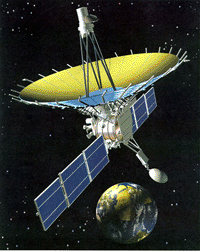
RadioAstron Mission
| Russion version | Last updated on May, 2008 |
 |
RadioAstron Mission |
RadioAstron project is an international collaborative mission to launch a free flying satellite carrying a 10-meter radio telescope in high apogee orbit around the Earth. The aim of the mission is to use the space telescope to conduct interferometer observations in conjunction with the global ground radio telescope network in order to obtain images, coordinates, motions and evolution of angular structure of different radio emitting objects in the Universe with the extraordinary high angular resolution.
The orbit of RadioAstron satellite will have apogee radius in the range up to 350 000 km. The spacecraft's operational lifetime will be no less than five years. Space-ground Very Long Baseline Interferometer (VLBI) measurements with this orbit will provide morphological and coordinate information on galactic and extragalactic radio sources with fringe size up to 8 micro arc second at the shortest wavelength 1.35 cm.
The RadioAstron program, initiated by Astro Space Center (ASC) of Lebedev Physical Institute of Russian Academy of Sciences (RAS) in collaboration with other institutions of RAS and Federal Space Agency (FSA), has expanded into a broad international collaboration: scientists from over 20 countries are constructing the instruments, planning the mission profile, and assuring ground radio telescopes support for RadioAstron. Russia will provide the satellite, most of the on-board hardware, interferometer integration and all kinds of the tests. General designer of satellite and SRT construction is Lavochkin Association (LA) of the RosKosmos.
Several other countries contribute to the on-board scientific payload. The 92-cm receiver is being built in India - National Center for Radio Astrophysics (NCRA) and Russia (Nizhny Novgorod, OAO KB "Gorizont"), the 18-cm receiver in Australia (CSIRO - Commonwealth Scientific and Industrial Research Organization), the 6-cm receiver by Russia, the 1.35-cm receiver by Finland (HUT - Helsinki University of Technology) and upgraded in USA (National Radio Astronomy Observatory- NRAO) and Russia (Moscow Institute of Radioengineering and Electronics - IRE), rubidium on-board frequency standard was built by the European Space Agency (ESA) at Neuchatel observatory in Switzerland. H-maser on-board frequency standard is being developed in Russia (Nizhny Novgorod, ZAO "Vremya-CH"). Russian (ASC) recording system on 6-system HDD and tapes will be able to accept a digital data stream at a maximum data rate of 128 Mbit/s. The correlator will be able to process the data from up to 5 interferometer stations (including the space element) at a maximum data rate of 128 Mbit/s. European Space Agency (ESA) participated in testing of the space radio telescope antenna. On board operating spacecraft system and command communication centers at Bear Lake (near Moscow) and near Ussuriisk (Eastern Russia), and also a tracking station at Pushchino are under preparation.
Main scientific goal of the mission is the study of various astronomical objects with unprecedented angular resolution up to few millionth of an arcsecond. The resolution achieved with RadioAstron will allow us in principle to study the following phenomena and problems: